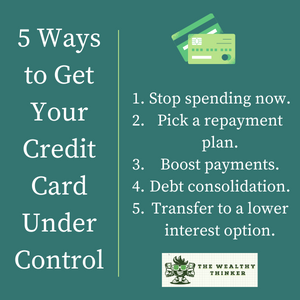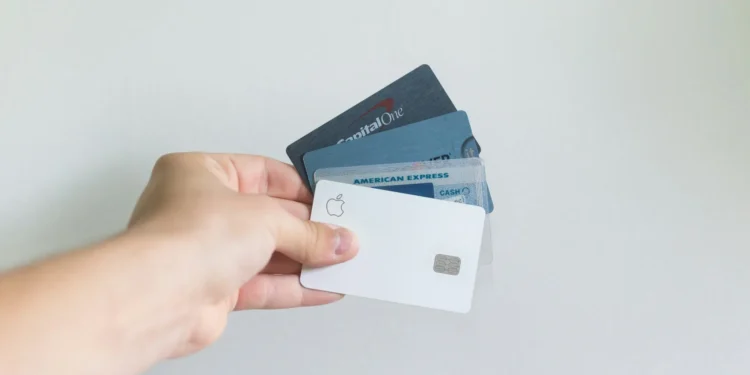Credit card debt is a pest eating deep into many pockets.
Sometimes, it’s easy to be seduced by the illusion of “free” money. Plenty of people are carefree about their credit card spending, thereby piling up more debt than they can carry.
On top of this, in the last few years, with inflation and interest rates rising, many people are simply stuck in a loop of persistent debt – where they’ve paid more in fees, interest and charges than they’ve paid back to their credit card balance.
Of course, this makes it difficult, if not impossible to get ahead.
Credit card debt makes up a significant portion of household debt in the United States, with the average American credit card debt sitting at $6,501.
On top of that, Americans collectively owe over $1.13 trillion in credit card debt, increasing by over $50 billion in the last quarter of 2023.
There is no doubt that credit card debt makes up a huge chunk of financial liability which most people bear. Having a grip on your credit card debt is a major milestone that you have to scale on your way to financial independence.
This isn’t exactly news – so how do you control credit card debt?
Here are some tips that can help.

5 Ways to Get Your Credit Card Under Control
1. Put a halt on credit card spending.
Putting a halt on credit card purchases not only reduces your debt load but also decreases your dependence on a credit card.
If you can maintain a cash-based budget consistently, you will find that you can plan your finances around your cash without needing extra money from your credit card. This also makes you more fiscally disciplined.
Swapping to cash may seem difficult at first as you are trying to acquire a new financial habit. You can ease yourself off credit cards moderately and make minor adjustments along the way.
2. Choose a repayment strategy.
Always have a strategy in place to control and reduce your credit card debt.
This implies having a well-thought-out plan on how to reduce your credit card liability. Having a debt repayment strategy makes it easier to keep track of your payments, and assess your progress.
There are two popular debt repayment strategies you can use to reduce debt. You can either decide to use debt avalanche or debt snowball to reduce your debt.
1. Debt Avalanche
Debt avalanche refers to a debt repayment method that focuses on paying debts with the highest interest rate first. This method reduces the overall amount you’ll pay because by targeting debts with high interest rates first, you reduce interest rates that would be accrued on the principal.
2. Debt Snowball
The second method is debt snowball. This is a debt repayment method whereby you target the smallest debt first, making your way up the repayment ladder to the highest debt. This method serves as a morale booster for those who may not be keen on tackling their biggest debts first.
Ultimately, you should choose the strategy that suits your present financial conditions and outlook.
Looking to get a credit card? Read this first: 5 Warning Signs you Absolutely Need to Know Before Getting a Credit Card
3. Increase your monthly payment.
Credit card debt does not have a prepayment penalty.
This means that you are not penalized if you pay off your debt ahead of time, unlike other forms of debt such as a mortgage or car loan. As such, one way to control your credit card debt effectively is by making payments above your required minimum.
This reduces overall interest because your extra payments reduce your principal.
4. Try debt consolidation.
Debt consolidation is the process of collecting all of your loans and taking another loan to pay them off.
These loans are then used to pay off multiple debts which are combined into a single sum.
Debt consolidation doesn’t erase the original debt, but transfers a consumer’s loans to a different lender or type of loan. Many people prefer to consolidate their loans because it provides the convenience of servicing only one loan with a lower overall interest rate.
However, this does not always mean you will get a lower interest rate. Many people find this route helpful in that they can focus on paying down one debt, rather than struggle with multiple.
Plus, debt consolidation does not clear up every issue if part of why you’ve found yourself in debt is due to frivolous spending, rather than say, student loans getting away from you, or losing your job, being ill, etc.
If you don’t also adjust your wealth mindset, you may just find yourself racking up the bills once you feel comfortable again.
5. Balance transfer to a lower interest rate.
While you will still have to pay attention to interest rates, transferring from a higher interest percentage credit card to a lower one, a 0% balance transfer card or even a personal loan, it will likely amount to much less overall.
Personal loan interest rates may depend on your credit score, and can range anywhere from 8% to 18%.
Home Equity Lines of Credit (HELOCs) have fixed interest rates and average around 9%.
0% balance transfer cards can give you a much lower, or no interest offer for a period of time. This will depend on your credit score and how big your balance is, but it’s still worth looking into as an option.
You may also have to pay a fee to transfer your balance, which would be something like 3-5% of the balance you transferred (So, for $1,000 transfer, you would pay $30-50 in fees.).
Pro tip: Pay close attention to introductory offers!! Businesses offering 0% balance transfer cards only offer that low, low rate for so long…then you could be back in 19-28% territory. While this option can certainly help you catch up on your credit card debt payments, remember that credit card companies still need to make money. They rely on people not staying up to date on this kind of thing.
Read this next: How to Know You Need Help Managing Your Debt
Conclusion
For some of us, the economic impact of the last few years has really hit us hard.
Maybe you have to use your credit card right now, because you’re figuring out your cash flow, are between jobs, or your overall debt has simply gotten away from you. Whatever it is, here you are, and you can always do something about it.
If you need more assistance or advice about getting out of debt, or figuring out what your options are, you could also reach out to a credit counseling service, such as The Credit Counselling Society. You could also reach out to your lender and see if they are willing to work with you on a repayment plan you can maintain.
Photo by Avery Evans on Unsplash



